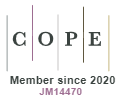Relação e comparação dos fatores peso ao nascer e idade gestacional com hemorragia peri-intraventricular
DOI:
https://doi.org/10.5585/23.2024.22958Palavras-chave:
Hemorragia cerebral, Idade gestacional, Peso ao nascer, Prematuridade.Resumo
Introdução: A hemorragia peri-intraventricular (HPIV) promove lesões neurológicas que acometem o recém-nascido, associadas à idade gestacional e ao peso ao nascer.
Objetivo: Determinar qual das variáveis, idade gestacional e peso ao nascer, tem predomínio com a HPIV e a prevalência dos hemisférios cerebrais.
Métodos: Estudo retrospectivo, analítico e transversal, com base na tabulação dos dados de 155 prontuários.
Resultados: Verificou-se que a HPIV está presente, predominantemente, de forma bilateral (59.3%), contudo, quando comparados os hemisférios, observa-se maior prevalência do lado direito (61.9%), ocorrendo a correlação inversa entre idade gestacional e hemorragia à direita (r: -0.166, p:0.04) nos diferentes graus de hemorragia, sendo que quanto maior a idade gestacional maior é a prevalência de hemorragia. Em relação ao peso ao nascer com hemorragia peri-intraventricular à direita, foi observada correlação inversa (r:-0.194, p:0.01), sendo que quanto menor o peso ao nascer maior a prevalência de HPIV à direita.
Conclusão: Os fatores idade gestacional e peso têm correlação com a presença da HPIV, sendo de maior frequência no hemisfério direito.
Downloads
Referências
Resch B, Vollaard E, Maurer U, Rosegger JHH, Muller W. Risk factors and determinants of neurodevelepmental outcome in cystic periventricular leucomalacia. Eur J Pediatr. 2000;159:663-70. https://doi.org/10.1007/PL00008403.
Gotardo JW, Volkmer NFV, Stangler GP, Dornelles AD, Bohrer BBA, Carvalho CG. Impact of peri-intraventricular haemorrhage and periventricular leukomalacia in the neurodevelopment of preterms: A systematic review and meta-analysis. Plos One. 2019;1-17. https://doi.org/10.1371/journal.pone.0223427
Abreu LC, Angheben JMM, Braz PF, Oliveira AG, Falcão MC, Saldiva PHN. Effect of the neonatal physiotherapy in the heart rate in preterm infant with respiratory distress syndrome after replacement of exogenous surfactant. Arq Med ABC. 2006; 31(1):5-11.
Jorch G, Jorch N. Failure of auto regulation of cerebral blood flow in neonates studies by pulsed Doppler ultrasound of internal carotid artery. Eur J Pediatr. 1987; 146:468-72. https://doi.org/doi: 10.1007/BF00441596
Vural M, Yilmaz I, Ilikkan B, Erginoz E, Perk Y. Intraventricular hemorrhage in preterm newborns: risk factors and results from a University Hospital in Istanbul, 8 years after. Pediatr Int. 2007;49(3):341-4. https://doi.org/10.1111/j.1442-200X.2007.02381.x
Khodapanahandeh F, Khosravi N, Larijani T. Risk factors for intraventricular hemorrhage in very low birth weight infants in Tehran, Iran. Turkish J Pediatr. 2008; 50(3):247-52.
Papile LA, Burstein J, Burstein R, Koffler H. Incidence and evolution of subependymal and intraventricular hemorrhage: a study of infants with birth weights less than 1,500 gm. J Pediatr. 1978;92:529-534. https://doi.org 10.1016/s0022-3476(78)80282-0
Klinger G, Osovsky M, Boyko V, Sokolover N, Sirota L, Lerner-Geva L et al. Risk factors associated with post-hemorrhagic hydrocephalus among very low birth weight infants of 24–28 weeks gestation. J Perinatol. 2016;36:557–63. https://doi.org/10.1038/jp.2016.18
Roze E, Kerstjens JM, Maathuis CG, Horst HJ, Bos AF. Risk factors for adverse outcome in preterm infants with periventricular hemorrhagic infarction. Pediatrics. 2008;122(1): e46-52. https://doi.org/10.1542/peds.2007-3305
Silveira RC, Procianoy RS. Lesões isquêmicas cerebrais no recém-nascido pré-termo de muito baixo peso. J Pediatr. 2005;81: S23-S32. https://doi.org/10.1590/S0021-75572005000200004
Poryo, M., Boeckh, J. C., Gortner, L., Zemlin, M., Duppré, P., Ebrahimi-Fakhari, et al. Ante-, peri-and postnatal factors associated with intraventricular hemorrhage in very premature infants. Early Hum Dev. 2018; 116, 1-8. https://doi.org/10.1016/j.earlhumdev.2017.08.010
Lacerda NA, Sá DMM, Ferreira LRM, Reicher LP, Bezerra TTB, Cavalcanti, TRF. Variação Anatômica de Artéria Vertebral: Um relato de caso. Rev. Ciênc. Saúde Nova Esperança – dez. 2016;14(2). http://186.227.198.185/index.php/revistane/article/view/86
Camfferman FA, de Goederen R., Govaert P. et al. Valor diagnóstico e preditivo do ultrassom Doppler na avaliação da circulação cerebral em prematuros: uma revisão sistemática. Pediatr Res. 2020; 87 (Suppl 1),50–58. https://doi.org/10.1038/s41390-020-0777-x
Noori S, Seri I. Hemodynamic antecedents of peri/intraventricular hemorrhage in very preterm neonates. Semin Fetal Neonat M. 2015;20(4). http://dx.doi.org/10.1016/j.siny.2015.02.004
Gilard V, Tebani A, Bekri S, Marret S. Intraventricular Hemorrhage in Very Preterm Infants: A Comprehensive Review. JPN J Clin Med. 2020;9(8):2447. https://doi.org/10.3390/jcm9082447
Tran U, Gray PH, O’Callaghan MJ. Neonatal antecedents for cerebral palsy in extremely preterm babies and interaction with maternal factors. Early Hum Dev. 2005; 81:555-61. https://doi.org/10.1016/j.earlhumdev.2004.12.009
Monteiro AMV, Lima CMAO, Ribeiro EB, Oliveira FC, Miranda S, Miranda LE. Apresentações de localização atípica de hemorragia no cérebro de recém-nascidos: considerações acerca de dois casos. Radiol Bras. 2009;42(6):403–405. https://doi.org/10.1590/S0100-39842009000600015
Marba ST, Caldas JP, Vinagre LE, Pessoto MA. Incidence of periventricular/intraventricular hemorrhage in very low birth weight infants: a 15-year cohort study. J Pediatr. 2011; 87(6):505-11. https://doi.org/ 10.2223/JPED.2137
Abreu LC, Souza AMB, Oliveira AG, Selestrin CC, Guerra MSB, Ferreira C, Murad N, Siqueira AAF. Incidência de Hemorragia peri-intraventricular em recém-nascidos pré-termo e a relação com o peso ao nascer. Rev Bras Crescimento Desenvolv Hum. 2007;17(2):24-30. https://doi.org/10.7322/jhgd.19829
Puerta-Martínez AG, Lopez-Garrido E, Guerrero-Nava JM, Vargas-Ruiz R, Martínez-Padrón HY. Risk factors associated with intraventricular hemorrhage in very-low-birth-weight premature infants. Child Nerv Syst. 2024;1-8. https://doi.org/10.1007/s00381-024-06310-1
Lin PY, Hagan K, Fenoglio A, Grant PE, Franceschini MA. Reduced cerebral blood flow and oxygen metabolism in extremely preterm neonates with low-grade germinal matrix- intraventricular hemorrhage. Sci rep-uk. 2016;6,25903 https://doi.org/10.1038/srep25903
Leijser LM, Linda SV. Preterm brain injury: Germinal matrix–intraventricular hemorrhage and post-hemorrhagic ventricular dilatation. Handb Clin Neurol. 2019;162: 173-199. https://doi.org/10.1016/B978-0-444-64029-1.00008-4
Özek E, Kersin SG. Intraventricular hemorrhage in preterm babies. Turk Pediatri Ars. 2020 Sep 23;55(3):215-221. https://doiórg/10.14744/TurkPediatriArs.2020.66742
Humberg A, Hartel C, Paul P, Hanke K, Bossung V, Hartz A, et al. Delivery mode and intraventricular hemorrhage risk in very-low-birth-weight infants: Observational data of the German Neonatal Network. Eur J Obstet Gyn R B. 2017;212; 144-149. https://doi.org/10.1016/j.ejogrb.2017.03.032
Downloads
Publicado
Como Citar
Edição
Seção
Licença
Copyright (c) 2024 Jadiane Dionisio, Bárbara Cristina Mattos

Este trabalho está licenciado sob uma licença Creative Commons Attribution-NonCommercial-ShareAlike 4.0 International License.
- Resumo 356
- pdf 294








